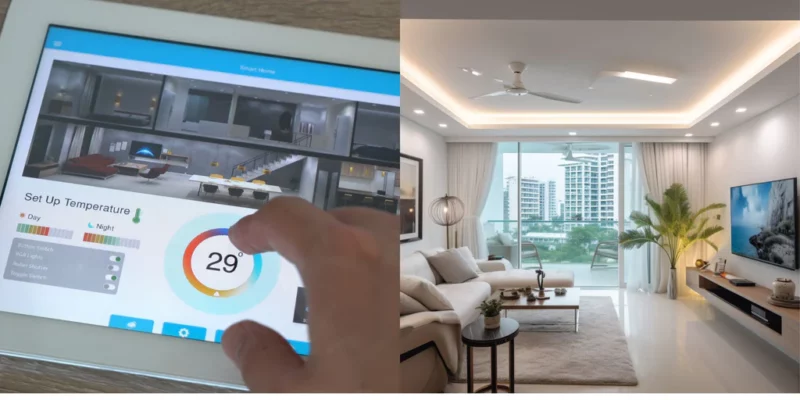In today’s fast-paced world, technology is evolving at an unprecedented rate. Smart home technology has become a significant part of our lives, revolutionizing the way we live and interact with our homes. When renovating your home, it’s essential to consider incorporating smart home technology to make your living space more efficient, convenient, and future-proof. In this article, we will explore the benefits of integrating smart home technology into your remodel and provide you with a comprehensive guide on how to do it effectively. In recent years, the concept of a smart home has transformed from science fiction into reality.
From controlling your thermostat with a smartphone app to having your lights adjust to your mood, smart home technology has made our lives more comfortable and efficient. This article will guide you through the process of incorporating smart home technology into your home remodel, helping you stay ahead in this digital age.
Understanding Smart Home Technology
What is Smart Home Technology?
Smart home technology refers to a network of devices and systems within your home that can communicate with each other and be controlled remotely. These devices are designed to make your life more convenient and efficient by automating tasks and providing remote access through your smartphone or voice commands.
How Does it Work?
Smart home devices connect to your home’s Wi-Fi network and can be controlled through a central hub or a smartphone app. They use sensors and internet connectivity to gather data and respond to your commands, allowing you to control various aspects of your home remotely.
Benefits of Smart Home Technology
Enhanced Convenience
When it comes to home renovation, one of the key advantages of integrating smart home technology is the heightened convenience it provides. You can effortlessly manage your lighting, thermostat, security systems, and even household appliances through a straightforward voice command or a quick tap on your smartphone.
Improved Energy Efficiency
Smart thermostats and lighting systems can help you save on energy bills by adjusting settings based on your preferences and occupancy. They can also provide real-time energy usage data, allowing you to make informed decisions about your energy consumption.
Enhanced Security
Smart security systems offer advanced features like motion detection, remote monitoring, and notifications, enhancing the security of your home. You can keep an eye on your property even when you’re away.
Increased Home Value
Homes equipped with smart technology often have a higher market value. Potential buyers are willing to pay more for homes with integrated smart systems due to the added convenience and energy savings they provide.
Popular Smart Home Devices
Smart Thermostats
Smart thermostats like the Nest Learning Thermostat can learn your temperature preferences and adjust settings accordingly. They can also be controlled remotely via a smartphone app.
Smart Lighting
Smart lighting systems like Philips Hue allow you to customize the color and intensity of your lights, create schedules, and control them remotely.
Smart Security Systems
Smart security systems and devices like Ring doorbell cameras and security cameras offer real-time video monitoring and notifications, enhancing the security of your home.
Voice Assistants
Voice assistants like Amazon Echo and Google Home can control various smart devices through voice commands, making it easy to manage your home.
Home Automation Hubs
Products like Samsung SmartThings act as central hubs, allowing you to connect and control multiple smart devices from different brands through a single platform.
Planning Your Smart Home Remodel
Assess Your Needs
Before you start incorporating smart technology into your remodel, assess your specific needs and priorities. Consider which aspects of your home could benefit the most from automation.
Budgeting for Smart Technology
Create a budget for your smart home remodel, taking into account the cost of devices, installation, and any necessary upgrades to your home’s infrastructure.
Compatibility and Integration
Ensure that the smart devices you choose are compatible with each other and can be integrated seamlessly into your existing home systems.
Installation and Setup
DIY vs. Professional Installation
Decide whether you want to install smart devices yourself or hire professionals. Some devices are easy to set up, while others may require professional installation. Smart home wiring is very important to set up correctly and future-proof!
Network and Connectivity
Ensure your home has a robust Wi-Fi network to support all your smart devices. A reliable network is essential for smooth operation.
Top Brands and Products
Nest
Nest offers a range of smart home products, including thermostats, cameras, and doorbells, known for their sleek design and user-friendly interfaces.
Philips Hue
Philips Hue provides customizable smart lighting solutions, allowing you to create the perfect ambiance in your home.
Ring
Ring specializes in home security with products like video doorbells and security cameras, offering peace of mind to homeowners.
Amazon Echo
Amazon Echo devices serve as voice-controlled hubs for smart home control and provide access to a wide range of third-party skills and apps.
Samsung SmartThings
Samsung SmartThings is a versatile hub that supports various smart devices and allows for extensive customization.
Smart Home Trends
Sustainable Living
Smart home technology can help you live a more sustainable lifestyle by optimizing energy usage and reducing waste.
Health and Wellness Integration
Incorporate devices that monitor air quality, provide health-related information, and promote a healthier lifestyle.
Challenges and Considerations
Privacy and Security
With the increased connectivity of smart devices, it’s essential to prioritize privacy and security. Regularly update your devices and use strong passwords.
Future-Proofing Your Investment
Technology evolves quickly. Choose devices and systems that are likely to remain compatible and receive updates in the future to ensure your investment lasts.
Conclusion
Incorporating smart home technology into your remodel is a smart decision for modern living. It enhances convenience, energy efficiency, and security while increasing the value of your home. Stay ahead of the curve by embracing the future of home living through smart technology integration.













Comments